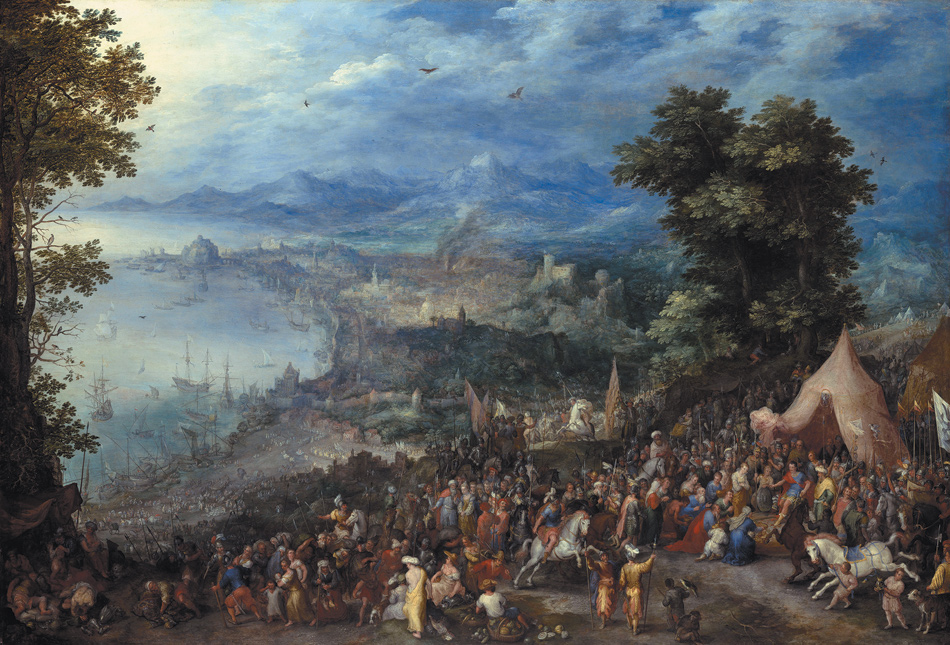Karel van Mander (1548–1606), the renowned biographer of the Netherlandish painters, concludes his life of Pieter Brueghel the Elder—the famous “Peasant Brueghel,” circa 1530–1569—with these sentences:
He was survived by two sons, both good painters themselves. The one named Pieter studied with Gillis van Conincxloo and paints likenesses from nature. Jan, after learning to paint in watercolors from his grandmother, the widow of Pieter Koeck van Aelst, went to a certain Pieter Goetkind, whose house was full of many beautiful objects, and from him learned to paint in oils. Later, he journeyed to Italy. He has garnered the highest praise for his marvelously painted small landscapes with very small figures.
Both father and sons worked in Antwerp, at that time the most important artistic center north of the Alps. It had a thriving art market and flourishing publishing houses that did an especially brisk business in engravings based on the works of the elder Brueghel. Nowhere else was the connection between early capitalism and the trade in images so efficiently organized.
It was an era of religious crises. Painting had lost its most important patron, the church. Antwerp had a central part in the emergence of new, secular subjects: landscapes and genre paintings. Pictures of peasant life—especially weddings and festivals, markets and money changers—were in demand by both galleries and private collectors. Pieter Brueghel the Elder overshadows all others as the artist who lent a monumental dignity to such secular scenes. His two sons drew upon that almost mythic legacy. Pieter Brueghel the Younger (1564–1637/38) specialized in large-format repetitions of his father’s compositions, which were obviously still in demand, although the original versions were long since in the possession of Emperor Rudolf II.
Jan (1568–1625) also owed much to his father’s legacy but went his own way. In his works for private collectors he minutely explored a range of subjects: forest landscapes, village streets, coastal panoramas with great congregations of people, nocturnes with glowing fires, mythological and hunting scenes, and finally, bouquets and wreaths with botanically accurate depictions of hundreds of flower species. These are artworks for the connoisseur and appreciating them almost requires a magnifying glass. As interesting and skillful as they are, they are not great masterpieces. They were painted at a time when the first naturalistic landscapes and depictions of society began to appear in Holland, and from 1610 onward, the star of Rubens was in the ascendant.
The last governor of the Spanish Netherlands was Maximilian II Emanuel of the Bavarian House of Wittelsbach. Thanks to his passion for collecting, and the transfer of work in Düsseldorf and Mannheim to Munich, the Alte Pinakothek there became the richest treasury of Flemish painting. Its Rubens collection is universally recognized for its brilliance and comprehensiveness and it overshadows the museum’s holdings of works by lesser Antwerp masters. Even so, the museum in Munich can show no fewer than forty-nine paintings by Jan Brueghel the Elder. Such riches, supplemented by loans from other museums, made it tempting to mount an exhibition that surveys Jan’s career. First, however, the Alte Pinakothek conducted technical analyses of the pictures to clarify their chronology and determine which were by Brueghel’s own hand and which were produced by his studio. The record of this effort is painstakingly (and at times rather minutely) recorded in the richly illustrated catalog—not exactly easy going even for aficionados.
Such a comprehensive exhibit is an occasion for the evaluation of an artist’s oeuvre. In the succession of pictures that march along the walls of this show, one comes across lovely surprises, first and foremost the great coastal landscapes, which span the distance between the cosmic immensity of creation and the Lilliputian scale of its human inhabitants, a theme already treated by his father, which Jan now raises to whimsical virtuosity. Jan Brueghel was neither a monumentalist nor a dramatist, but rather a subtle master of the finest brushwork and positively microscopic precision of detail. In his letters to Federico Borromeo, the archbishop of Milan and his most important patron, he wrote, “Everything has been painted after nature and with the greatest care” and “You will be amazed by this work.” Visitors to this show will indeed want to inch along in wonder from one minuscule detail to the next.
Some works stand out. In seaside scenes such as the Large Fish Market of 1603 or View of a Seaport with the Continence of Scipio of 1600, Jan combines an immense sweep of shore and sea with elements from genre or history painting. The sky arches over the water in opalescent blues and yellows. On the coast rise buildings, some realistic and others fantastical, that recall Rome or Naples. The foregrounds teem with thousands of tiny figures whose every detail is minutely reproduced. The detail of this miniature swarm absorbs all sense of greatness or pathos. Even the depiction of the crucifixion in Jan’s painting of Calvary from 1598 dissolves into a genre or history painting with its multiplicity of figures. The contrast to sacred ecclesiastical painting could not be more stark. Everything merges into an imitation of nature. There is a sense of democracy in these panoramas that include room for every kind of human activity.
Advertisement
Hardly any of Jan’s landscapes are without this human bustle. A recurring motif are the carts trundling along roads that wind across fields and through forests, past windmills and into villages where pigs root in the streets. The governor and his wife stroll before the Castle of Mariemont. Women along the road kowtow to him and a man raises his hat and drops to his knee. But we also find a picture that shows travelers being luridly ambushed by highwaymen. The thirst for sensational narrative was no respecter of class.
Jan returned from Italy in 1596 and appears to have quickly risen to fame and fortune. By 1602 he had become a dean of the Antwerp Guild of Saint Luke and in 1604 he purchased a handsome house in the Lange Nieuwestraat. He was obviously well connected among the circle of local painters. Around 1613, he journeyed to Holland with Rubens and Hendrik van Balen (1575–1632). The high demand for paintings led artists to cooperative methods of production. Even a universal genius like Rubens hired specialists to paint the animals in his pictures.
Hendrik van Balen was Jan’s most important collaborator. In fact, it must be admitted that starting about 1610, it is van Balen’s contribution that predominates in the mythological and allegorical canvases bearing Jan’s name. Van Balen was responsible for the colorful figures that are their main focus while Jan merely added the background landscapes—the green trees behind The Feast of the Gods or The Triumph of Bacchus. The balance of cooperation has been reversed, Jan working as the landscape specialist for van Balen, who devotes himself to loftier subjects. The microscopic mimesis with which Jan depicted the hustle and bustle of his tiny figures around 1600 belonged to the Mannerist past and is now succeeded by pleasing, innocuous, porcelain-like mythological paintings that stand in the shadow of Rubens’s mighty example.
The hunting scenes that appear with increasing frequency around 1620 have a different history. For the mythological figures—Diana and her nymphs—Jan employs members of Rubens’s studio, while his own specialty is the prey: dead stags and wild boars, foxes and fowls, in addition to anatomically exact depictions of every possible canine breed. Here, he is back in his element: exact rendering. A panel with studies of dogs reveals how carefully he prepared for these paintings. And in fact, a real pearl is to be found among all the paraphernalia of the hunt: the Vision of Saint Hubert. In the stag standing as still as a stuffed specimen and bearing the crucifix between its antlers, Jan’s mimesis is transformed into a miraculous vision. Rubens himself painted the figure of the noble hunter-saint kneeling before the stag and the Cross.
Jan the imitator of nature was also a brilliant pioneer in the genre of floral painting. Pausias was celebrated in antiquity as a painter of flowers, and Jan Brueghel is his modern reincarnation. He paints large canvases with magnificent bouquets. We see roses, lilies, and the only recently imported tulips in addition to a legion of smaller blossoms. Among the blooms we discover beetles and butterflies. His floral painting invades the lofty realm of mythology as well: in collaboration with van Balen, Jan painted the decorations for Flora, the goddess of flowers, enthroned in a garden filled with blossoms and regarding herself in a mirror like Venus.
In his floral wreaths for devotional pictures of the Virgin, Jan’s flower painting achieves a sacral nobility. The exhibition includes an enchanting Holy Family, sitting outdoors and framed by a garland of fruit and flowers. Along the lower edge, small monkeys can be seen, a witty allusion to painting’s aping of nature.
When Rubens painted a Madonna and Child surrounded by blissful and jubilant putti, he asked his friend Jan Brueghel to adorn the picture with a wreath of flowers; it is Jan’s most beautiful floral painting. His lilies and roses remind us of their metaphoric use in Mariological poetry; here mimesis becomes poetry. Jan Schmidt has contributed an illuminating essay to the exhibition catalog on the production process for this festive painting.
Advertisement
But the monumental panel sheds both light and shadow on Jan Brueghel’s position in the history of art. In the great concert of Baroque painting in Antwerp, he remains an outstanding specialist. The difficulty with this visually pleasing show is that it seeks to count its hero among the very greatest painters, and by so doing obscures his true historical significance.
This Issue
June 20, 2013
What Is a Warhol?
Cool, Yet Warm
Facing the Real Gun Problem








